GENETICS
Concept of Genetics
The concept of the Genetics
Explain the concept of the genetics
Genetics is the study of heredity and variations in organism. Through this statement there are two common words that are heredity and variation.
Heredity is the passing on of characteristics from parents to the off spring.
Variation is the observable differences in organisms from the same species.
The hereditary characteristics are passed from parents to their offspring through distinct units called genes.
Genes are hereditary materials or factors, which determine a specific characteristic or trait in an organism.
Common terms used in Genetics
State common terms used in genetics
First filial generation (F1)
This is arising from the crossing of two pure breeds
Second filial generation (F2)
This is the generation obtained by crossing individuals of the first filial generation.
Genotype
This is the genetic makeup of an organism or an individual
Phenotype
This is the outward appearance determined by a gene
Haploidy (n)
Having one set of unpaired chromosomes in the nucleus
Diploidy (2n)
Having two sets of homologous (similar) chromosomes in the nucleus
Alleles
It is the alternative number of genes in the nucleus or in the same position
Homozygosity
The state of possessing two identical forms of a particular gene, one inherited from each parent. For example, a girl who is homozygous forcystic fibrosis(CF) received the cystic fibrosis gene from both of her parents and therefore she has cystic fibrosis.
Heterozygosity
Thestateofbeingheterozygous;havingtwodifferentallelesofthesamegene
Dominance
This is a condition where an allele can express itself in the presences of other alleles. Example: ‘Tt’ where ‘T’ is the dominant that expresses its effect in the presence of ‘t’.
Recessiveness
A condition where an allele can only express itself when they are in homozygous form but does not express its effect on the presence of other alleles.
Mutation
A sudden random change in the genetic make up of a cell, causing it and all cells derived from it to differ from normal cells.
Mutagen
This is an agent capable of increasing the rate of mutation in an organism like formaldehyde and nitrous acid.
Selfing
It is the crossing offspring of the same pair of parents.
Genetics Materials
The concept of Genetics Materials
Explain the concept of genetics Materials
Hereditory characteristics are passed from parents to their offspring through distinct units called genes.There are a lot of genes in an organism’s body. Genes are arranged in a linear manner, making chromosomes.
Chromosomes are thread like structures found in the nuclei of all body cells. Gene is made up of chemical substances called Nucleic acid.
There are two types of nucleic acids found in cells, these are:
- Deoxyribonucleic acid (DNA)
- Ribonucleic acid (RNA)
These acids are made up of building blocks called nucleotides. Each nucleotide consists of three molecules linked together, that is a pentose sugar, phosphoric acid and organic base.
The structure and composition of Genetics Materials (Deoxyribonucleic Acid and Ribonucleic Acid )
Describe the structure and composition of genetics materials (Deoxyribonucleic Acid and Ribonucleic Acid )
DNA is called the “molecule of life”. This is because it determines the physical and behavioural characteristics of an organism. The DNA determines example the colour of your hair, eyes, skin, ears and nose, height, ability or inability to roll the tongue all.
he DNA is made up of many nucleotides that make the double stranded.
STRUCTURE OF DNA
DNA is a double stranded helical (spiral) molecular chain of a nucleic found within the nucleus of a cell.By “double stranded helical” it means that the DNA consists of two strands, which twist around each other in a spiral fashion.
The DNA is made up of many nucleotides forming a polynucleotide chain. Polynucleotide means many nucleotides
The polynucleotide chain runs in the opposite direction. Each chain is joined to the other by pairs of bases. There are four bases namely Guanine (G), Cytosine ©, Adenine (A) and Thymine (T)
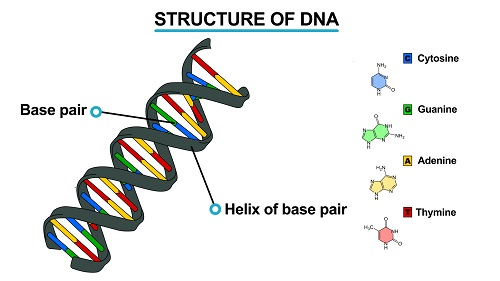
Note:
Guanine and adenine are collectively called purines while cytosine and thymine are collectively called pyrimidine
Guanine pairs with cytosine and adenine pairs with thymine.DNA plays a key role in inheritance because it replicates itself during mitosis and meiosis. DNA also undergoes changes and has genetic information the characteristics of a species.
RNA
The chromosomes replicate during cell division. The replication occurs during mitotic and meiosis cell divisions
The chromosomes determine the type of protein synthesized. The genes determine the actual characteristics of the organisms. In protein synthesis deoxyribonucleic acid acts as a template for the formation of ribonucleic acid (RNA).
STRUCTURE OF RNA
RNA consists of only a single strand of polynucleotide. The polynucleotide is made up of many nucleotides. Each nucleotide consists of a nucleobase, ribose sugar and phosphate group.The RNA sugar is ribose and not deoxyribose. Its nucleotides contain only one of four bases that are:
- Guanine (G)
- Cytosine (C)
- Adenine (A)
- Uracyl (U)
NB:Uracyl replaces the thymine of DNA. So in this the adenine can pair with uracil while the Guanine pairs with thymine.
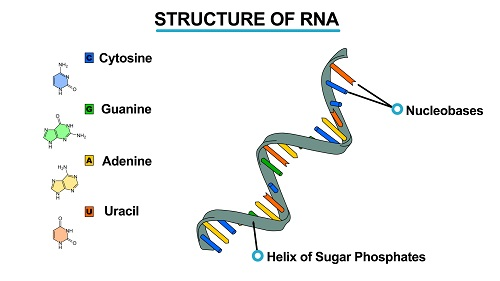
The RNA is involved in protein synthesis. There are various types of RNA:
- Messenger (mRNA)
- Transfer (tRNA)
- Ribosomal (rRNA)
Difference between Deoxyribonucleic Acid (DNA) and Ribonucleic Acid (RNA)
Differentiate Deoxyribonucleic Acid (DNA) from Ribonucleic Acid (RNA)
DNA versus RNA comparison chart
| DNA | RNA | |
|---|---|---|
| Stands For | DeoxyriboNucleicAcid. | RiboNucleicAcid. |
| Definition | A nucleic acid that contains the genetic instructions used in the development and functioning of all modern living organisms. DNA's genes are expressed, or manifested, through the proteins that its nucleotides produce with the help of RNA. | Theinformation found in DNA determines which traits are to be created, activated, or deactivated, while the various forms of RNA do the work. |
| Function | The blueprint of biological guidelines that a living organism must follow to exist and remain functional. Medium of long-term, stable storage and transmission of genetic information. | Helps carry out DNA's blueprint guidelines. Transfers genetic code needed for the creation of proteins from the nucleus to the ribosome. |
| Structure | Double-stranded. It has two nucleotide strands which consist of its phosphate group, five-carbon sugar (the stable 2-deoxyribose), and four nitrogen-containing nucleobases: adenine, thymine, cytosine, and guanine. | Single-stranded. Like DNA, RNA is composed of its phosphate group, five-carbon sugar (the less stable ribose), and four nitrogen-containing nucleobases: adenine, uracil (not thymine), guanine, and cytosine. |
| Base Pairing | Adenine links to thymine (A-T) and cytosine links to guanine (C-G). | Adenine links to uracil (A-U) and cytosine links to guanine (C-G). |
| Location | DNA is found in the nucleus of a cell and in mitochondria. | Depending on the type of RNA, this molecule is found in a cell's nucleus, its cytoplasm, and its ribosome. |
| Stability | Deoxyribose sugar in DNA is less reactive because of C-H bonds. Stable in alkaline conditions. DNA has smaller grooves, which makes it harder for enzymes to "attack." | Ribose sugar is more reactive because of C-OH (hydroxyl) bonds. Not stable in alkaline conditions. RNA has larger grooves, which makes it easier to be "attacked" by enzymes. |
| Propagation | DNA is self-replicating. | RNA is synthesized from DNA when needed. |
| Unique Features | The helix geometry of DNA is of B-Form. DNA is protected in the nucleus, as it is tightly packed. DNA can be damaged by exposure to ultra-violet rays. | The helix geometry of RNA is of A-Form. RNA strands are continually made, broken down and reused. RNA is more resistant to damage by Ultra-violet rays. |
Principle of Inheritance, Concept of Inheritance
The Concept of Inheritance
Explain the concept of inheritance
Gregor John Mendel advanced the principles of inheritance. In 1856 – 1863 Mendel grew and tested some 29,000-pea plants. From these studies, he formulated the law of segregation and the law of assortment.
After his work on peas, Mendel began to experiment with honeybees. However, he failed to produce a clear picture of their heredity because of difficulties in controlling the mating behaviour of queen bees.Mendes works was largely criticized and generally rejected during his lifetime. It was only after his death that his work gained broad recognition. He is now considered the father of modern genetics, Mendel diedMendel died on January 6th, 1884.
Mendel chose the garden peas because of the following reasons:
- It is self-pollinating but can be cross-pollinated
- It matures very fast
- It produces many seeds and hence many off springs
- It has several physical properties
Some of the characteristics that be studies were:
- Height of the stem-tall or dwarfs
- Texture of the seed coat – smooth or wrinkled
- Colour of flowers – purple or white
- Colour of pods – green or yellow
- Position of flowers – axial or terminal
Mendelian Inheritance
Mendel’s First Law of Inheritance
State Mendel’s first law of inheritance
FIRST LAW
This law is also called Mendel’s first law of inheritance or law of segregation. The law states, “An organism’s characteristics are determined by internal factors which occur in pair”. Only one of the factors can be contained in a single gamete.
In modern terms this means that genes occurring in pairs control the characteristics of an organism but only one gene can be carried in a single gamete.
There are four main concepts in this law:
- Genes can exist in more than one form
- An organism inherits two alternative form of a gene for a particular trait, one from each parent
- During the production of gametes pair of alleles separate. Thus each gamete has one allele for each trait.
- When the two alleles in a pair are different one is dominant while the other is recessive. This condition is called complete dominance.
When inheritance of one pair of characteristics is studied at a time it is called Monohybrid inheritance.
Monohybrid Crosses and Interpretation of their Results of Crosses and Ratios
Illustrate monohybrid crosses and interpret their results of crosses and ratios
MONOHYBRID INHERITANCE
This is an inheritance of one pair of characteristic or trait at a time.
Example 1:
Mendel selected tall plants and self pollinated them.
Consider below
chart Tall x Tall
His results were that all trees were tall.
Also he cross-pollinated the pure breed tall plant and pure breed short (dwarf) plants. Consider belowchart Tall x dwarf
All plants produced are normal and also are known as the first filial generation (F1).Hence he concluded that the tallness is said to be dominant which the gene for dwarfness is said to be recessive in the garden pea. Because the gene of dwarf are masked by the gene for tallness.Hybrid is an offspring of a cross-between parents showing unlike characteristics.Test Cross (Back cross) this is the cross that involves off springs of two different pure lines.
Interpretation of data from Monohybrid Experiments to Demonstrate Mendel’s First Law of Inheritance
Interpret data from monohybrid experiments to demonstrate mendel’s first law of inheritance
Some conditions in human follow Mendelian monohybrid inheritance. Example, a condition that is associated with a simple pair of alleles and are inherited in Mendelian fashion
Examples of such conditions are:
- Albinism
- Sickle Cell anemia
- Rhesus blood group
- Haemophilia
- Achondroplasia
Patterns of Inheritance that Follow Mendel’s First Law
Illustrate patterns of inheritance that follow mendel’s first law
DIHYBRID INHERITANCE
Mendel continued to study the inheritance of two pairs of characteristics. This inheritance is known as dihybrid cross.Dihybrid Cross is the inheritance of two characteristics in which each is controlled by a different gene, different locus.
Examples of two characteristics to an organism:
- Tall with purple flower
- Dwarf with white flower
From the above experiment Mendel made the following conclusions:
- Two phenotypes in the ration 9:3:3:1 resembled one or other of the parent
- Two phenotypes did not resemble any of the parents’ phenotypes but instead had combined the characteristics of both parents
- Ratio of tall to dwarf plants was 3:1 and that of purple flowered plant was 3:1
Non-Mendelism Inheritance
Concepts of Incomplete Dominance and Co-dominance
Explain concepts of incomplete dominance and Co-dominance
Not all inheritance follows Mendelian fashion. Mendel only considered characteristics that were determined by single genes with two alleles in which one is dominant and the other recessive. Later research showed that in some alleles neither one is dominant over the other. That condition is known as co-dominance or incomplete dominance.
Incomplete Dominance
This is the condition in which no allele is dominant or recessive compared to the otherExample when red and white flowered varies of the four o’clock plant are crossed, all the plant of the F1 generation produce pink flowers.
Complete dominance
Complete Dominance is a condition in which a dominant gene completely masks recessive gene. Example: Homozygous tall plant crossed with the homozygous short/dwarf plant. chart showing Tall x Dwarf.
Patterns of Inheritance that deviates from Mendel’s First Law of Inheritance
Illustrate patterns of inheritance that deviates from mendel’s first law of inheritance
NON-MENDEL INHERITANCE
Not all inheritance follows Mendelian fashion. Mendel only considered characteristics that were determined by single genes with two alleles in which one is dominant and the other recessive. Later research showed that in some alleles neither one is dominant over the other. That condition is known as co-dominance or incomplete dominance.
INCOMPLETE DOMINANCE
This is the condition in which no allele is dominant or recessive compared to the other
Example when red and white flowered varies of the four o’clock plant are crossed, all the plant of the F1 generation produce pink flowers.
Consider belowchart Red x White
INHERITANCE OF ABO BLOOD GROUPS
The entire human population falls under four main blood group that are –A, B, AB and O.Allele A and B are condomint white allele O is recessive to both A and B.
Example: parents with heterozygous blood group A and B have off spring with blood group A, B, AB and O as illustrated in the following cross.
Phenotype Blood group A x Blood group Bchart
Sex Determination and Inheritance
The Mechanism of Sex Determination and Inheritance
Describe the mechanism of sex determination and inheritance
Human beings have 46 chromosomes (23 pairs of homologous chromosome). In every body cell of these, two are sex chromosomes while 44 are referred to as Autosome.
By definition:
Sex determination refers to the interpretation between male sex and female sex.
A diagrammatical representation of human sex determination is shown below.chart showing cross Male x Female
The Concept of Sex Linked, Sex Limited and Sex Influenced Characters
Explain the concept of sex linked, sex Limited and sex influenced characters
This refers to the tendency in which one chromosome carries other genes.
Unlike other chromosomes in which each of the homologous chromosomes carries gene for the same characteristics, X and Y do not carry the same gene.
Consequences of Sex Preference and Sex Selection
Explain consequences of sex preference and sex selection
Sex preference and selection is the tendency of people to like one type of sex more than the other. This tendency is very common in African countries and some parts of Asia.
Some people in a family prefer having boys than girls while others prefer girls to boys. Those who prefer boys do so in a belief that boys will perpetuate the linage and take care of the parents when females are living far away with their husbands. Those who prefer girls argue that, girls are kind and merciful; therefore they can take care of their parents in old age.
The sex preference and selection is influenced by a number of socio-cultural factors. Some of the factors include the following:
- Manpower Generation:Some societies prefer boys to girls because they generate wealth upon getting married. A family will get a lot of cattle or money as bridal price.
- Generation and protection of wealth:Some societies prefer girls more than boys because girls will prefer to have more sons than girls so that they can somehow benefit indirectly through their son.
- Land ownership In some societies a woman cannot own land thus prefers more sons than daughters because they can benefit from the sons.
Variation Among Organisms
The concept of Variation
Explain the concept of variation
Variation, in biology, refers to any difference between cells, individual organisms, or groups of organisms of any species caused either by genetic differences (genotypic variation) or by the effect of environmental factors on the expression of the genetic potentials (phenotypic variation). Variation may be shown in physical appearance, metabolism, fertility, mode of reproduction, behaviour, learning and mental ability, and other obvious or measurable characters. If you consider almost any characteristic, you will find differences between various people (or other animals or plants) in a population.
Variations among Organisms
Identify variations among organisms
Genetic variation describes naturally occurring genetic differences among individuals of the same species. This variation permits flexibility and survival of a population in the face of changing environmental circumstances. Consequently, genetic variation is often considered an advantage, as it is a form of preparation for the unexpected. Variation between different species is always greater than the variation within a species.
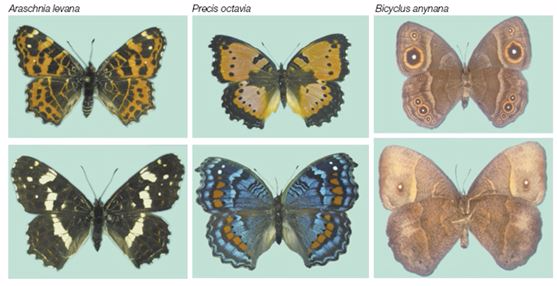
Genetic variations are caused by differences in number or structure of chromosomes or by differences in the genes carried by the chromosomes. Eye colour, body form, and disease resistance are genotypic variations. A variation cannot be identified as genotypic by observation of the organism. Breeding experiments must be performed under controlled environmental conditions to determine whether or not the alteration is inheritable.
Environmentally caused variations may result from one factor or the combined effects of several factors, such as climate, food supply, and actions of other organisms. These variations do not involve any hereditary alteration and in general are not transmitted to future generations.
The Meaning of Continuous and Discontinuous Variations
Give the meaning of continuous and discontinuous variations
Types of variation
Variations are classified either as continuous, or quantitative (smoothly grading between two extremes, with the majority of individuals at the centre, as height in human populations); or as discontinuous, or qualitative (composed of well-defined classes, as blood groups in man). A discontinuous variation with several classes, none of which is very small, is known as a polymorphic variation. The separation of most higher organisms into males and females and the occurrence of several forms of a butterfly of the same species, each coloured to blend with a different vegetation, are examples of polymorphic variation.
Continuous variation
This type of variation exhibits a wide range of differences for the same characteristics, from one extreme end to the other. Characteristics showing continuous variation vary in a general way, with a broad range, and many intermediate values between the extremes. As a matter of fact, if you consider a large enough sample from a population, perhaps plotting frequency as a histogram or as a frequency polygon, you will find that most of the values are close to the average (mean), and extreme values are actually rather rare. Examples of continuous variations in human beings include weight, height and complexion. Height is an example of continuous variation. People vary in height from very short to very tall, with many intermediate heights.
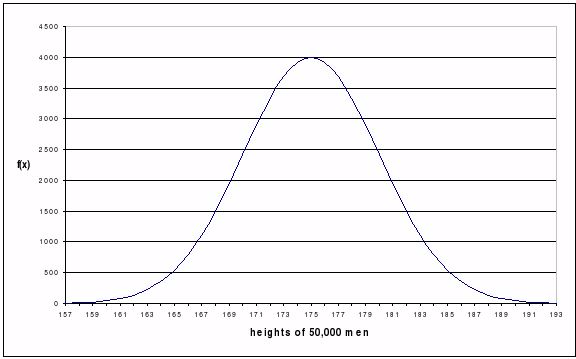
A frequency polygon for continuous variation
Discontinuous variation
Discontinuous variation is a type of variation that shows sharp differences among individuals of a species, with no intermediate forms.
Individuals fall into a number of distinct classes or categories. This is based on features that cannot be measured across a complete range. A person either has the characteristic or not. There is no intermediate condition.
The ability to roll the tongue (one is either tongue roller or non tongue roller), fingerprints, sex (one is either male or female) and the ABO blood group system where one can only have blood group A, B, AB or O. and blood groups. In plants, a pawpaw tree is either male or female. These characteristics can be explained much more easily by simple rules of genetics and are less likely to be affected by other factors. Discontinuous variations are unchangeable and unaffected by the external environment.
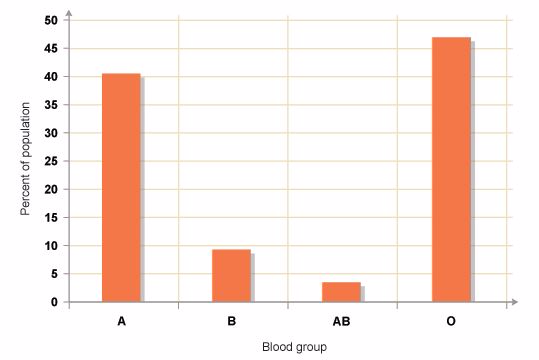
Discontinuous variation of blood groups
Difference between Continuous and Discontinuous Variation
Differentiate continuous from discontinuous variation
Some of the major differences between continuous and discontinuous variations in inheritance are as follows:
Continuous Variations:
- The variations fluctuate around an average or mean of species.
- Direction of continuous variations is predictable.
- They are already present in the population.
- Continuous variations are formed due to chance segregation of chromosomes during gamete formation, crossing over and chance pairing during fertilization.
- They can increase adaptability of the race but cannot form new species.
- Continuous variations are connected with the mean or average of the species by intermediate stages.
- The continuous variations are also called fluctuations.
- When represented graphically, continuous variations give a smooth bell shaped curve.
- They are very common.
- Continuous variations do not disturb the genetic system.
Discontinuous Variations:
- A mean or average is absent in discontinuous variations.
- The direction of discontinuous variations is unpredictable.
- Discontinuous variations are new variations though similar variations might have occurred previously.
- Discontinuous variations are produced by changes in genome or genes.
- Discontinuous variations are the fountain head of continuous variations as well as evolution
- These variations are not connected with the parental type by intermediate stages.
- Discontinuous variations are also known as mutations or sports.
- A curve is not produced when discontinuous variations are represented graphically.
- These variations appear occasionally.
- They disturb the genetic system of the organism.
Causes of Variation among Organisms
Explain causes of variation among organisms
Variation can be due to inheritance, and also to environmental factors such as climate and diet.
Genetic causes of variation (inherited variation)
Some variation within a species is inherited. Variation in a characteristic that is a result of genetic inheritance from the parents is called inherited variation. Each egg cell and each sperm cell contains half of the genetic information needed for an individual. When these join at fertilisation a new cell is formed with all the genetic information needed for an individual. Examples of inherited characters in humans include eye colour, hair colour, skin colour and lobed or lobeless ears.
Gender is inherited variation too, because whether you are male or female is a result of the genes you inherited from your parents.
Genetic variation can be caused by mutation (which can create entirely new alleles in a population), random mating, random fertilization, and recombination between homologous chromosomes during meiosis (which reshuffles alleles within an organism's offspring). Some of these variation causes are explained in detail below:
Independent assortment of homologous chromosomes
This occurs at the time of gamete formation. At the time of gamete formation during meiosis, the parental chromosomes separate at random hence forming different gametes with different chromosomes. This independent assortment gives a wide variety of different gametes and hence individuals.
Crossing-over
Chromosomal crossover (or crossing over) is the exchange of genetic material between homologous chromosomes that results in recombinant chromosomes during sexual reproduction. Crossing over and random segregation during meiosis can result in the production of new alleles or new combinations of alleles. Portions of paired chromosomes may be exchanged to form new chromosomal and gene combinations in gametes resulting into new trait combinations in offspring.
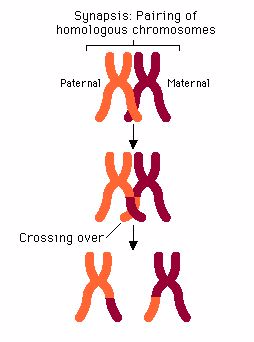
The process of crossing over
Non-disjunction
Non-disjunction results into doubling of the chromosome number due to failure of chromosomes to segregate during meiosis. This leads to increase in cell size and subsequent increase in size of various parts of the organism, hence variation.
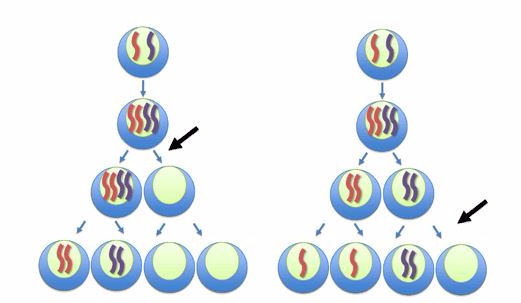
Non disjunction process
Random fertilization
Random fertilization that results during the fusion of the gametes also contributes to variation. Gametes are the egg and sperm, or pollen, produced by meiosis. Each gamete has a unique set of combination of genes. A male gamete can fertilize any of the female gametes. The fertilization between a male gamete and a female gamete occurs randomly in the fallopian tube. As a result, each zygote is unique and hence variation occurs due to the different combination of genes from the male and female gamete.
The random fusion of gametes is a source of genetic variation in offspring (with the same parents). For example, a litter of puppies or kittens sired (bred) by the same father will show variation between individuals as shown bellow.
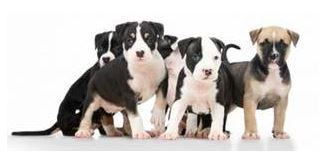
Variation among puppies sired by the same father
Random mating
Random mating involves individuals pairing by chance, not according to their genotypes or phenotypes. Random mating is a source of variation in a population. For example, a population in which mating only occur between organisms of similar phenotypes, such as red beetles mating with red beetles and yellow beetles mating with yellow beetles, will tend to show less variation than a population where crosses are random. For example, red beetles mating with yellow beetles.
Mutations
Mutations are sudden and permanent changes in the genes and chromosomes which are then passed on from cell to cell during mitosis. Such changed genes or chromosomes will produce offspring that differ from parents.
Environmental causes of variation
Characteristics of animal and plant species can be affected by factors such as climate, diet, accidents, water, temperature, light, diseases, degree of acidity, soils nutrients, culture and lifestyle. For example, if you eat too much you will become heavier, and if you eat too little you will become lighter. A plant in the shade of a big tree will grow taller as it tries to reach more light. Such variations are produced in the body (somatic) cells and not in the sex cells hence cannot be inherited.
Variation caused by the surroundings is called environmental variation. Here are some other examples of features that show environmental variation:
- Your language and religion
- Flower colour in hydrangeas - these plants produce blue flowers in acidic soil and pink flowers in alkaline soil
Genetic Disorders
The meaning of Genetic Disorders
Give the meaning of genetic disorders
This refers to an abnormality, which results from problems in the genes of an organism, and it is inherited. This means that the genetic disorder is caused by the change in the gene or chromosomes due to an error in the person’s genetic materials.
OR
Genetic disorders are malfunctioning of the body’s physiological mechanisms due to changes on gene or chromosomes; for example the change in number of chromosomes from 46 to 47 chromosomes or below that hence leading to genetic disorders.
Examples of Genetic Disorders
Cite examples of genetic disorders
Genetic disorders includes:
- Down’s Syndrome or Mongolism/Mongolia
- Turner Syndrome
- Super male and Super female
- Haemophilia
- Colour blindness
NOTE: The changes in the genes and chromosomes may be caused by different factors, which lead to genetic disorder. The sudden change in genetic materials of the cell that may cause it to differ from other cells is known as mutation.
The Causes and Effects of Genetic Disorders
Explain the causes and effects of genetic disorders
An organism is affected by mutation, which occurs naturally at a low rate. A number of factors may contribute to mutation. Such factors include various chemicals and radiation example X-rays. Mutation can be due to a change in gene itself i.e. this is called point mutation only or in the arrangement of gene chromosome. Other causes of mutation include addition or loss of chromosomes and duplication of genes.
There are two types of mutation including chromosomal mutation and gene mutation. Both leads to the genetic disorder is to lead to change in gene and chromosome. Chromosomal mutation leads to genetic disorder like Down’s syndrome, Turner Syndrome, Klinefelter’s Syndrome. It affects the appearance or the number of chromosomes. Gene mutation leads to genetic disorders like Haemophilia and Colour blindness, which affects the genes.
Down’s syndrome or Mongolism:
This is a chromosomal abnormality in which there are three copies of chromosome number 21 instead of the usual 2. The person with Down’s syndrome therefore has 47 chromosomes in his/her body cells. The affected individuals have a short broad face, slanted eyes, short fingers and weak muscles. Such individuals are usually mentally retarded.
The presence of the extra chromosome on chromosome 21 is known as trisomy. The extra chromosome on chromosome 21 is due to its failure to separate during meiosis. This is known as non-disjunction. This non-disjunction occurs when homologous chromosome fail to separate in meiosis II of the egg. Therefore after the fertilization, chromosome 21 will contain 3 (i.e. the 2 which failed to separate plus the one from the father) instead of normal two (i.e. each from one parent). In some few cases non-disjunction may occur in the father’s sperm.
Causes of Down’s syndrome
An extra chromosome on chromosome 21, thus making three instead of two, causes this disorder. The extra chromosome on chromosome 21 is caused by failure to separate during meiosis.
Effects of Down’s syndrome
People with down’s syndrome are very susceptible to diseases including heart diseases. They thus die young, mostly not more than 30 years. They may also suffer discrimination in those societies that consider it as a curse or something very unusual.
Turner’s syndrome (XO)
This is a genetic disorder of female (women) caused by absence of second sex chromosome. Such women are XO, rather than the normal XX chromosome. In this disorder there are only 45 chromosomes, the female lacks secondary sexual feature, small uterus, the internal genitals never mature and therefore she is sterile. This disorder is characterized by lack of ovaries and menstrual cycle.
Causes of Turner’s syndrome
This genetic disorder is caused by absence of X chromosome in normal XX chromosome. This occurs when the second X chromosome lacks i.e. make XO instead of normal XX chromosome.
Effects of Turner’s syndrome
- The women who suffer from Turner’s syndrome are abnormally short; their ovaries usually do not develop and hence are infertile.
- They may also suffer mental abnormalities, which may lead to difficulty in learning
- Missing one copy of this gene causes short stature and skeletal abnormalities in women with Turner’s syndrome. This is due to the researchers who identified one gene called SHOX that is important for bone development and growth, hence when missing it will cause skeletal abnormalities.
Super Male and Super Female
This is the genetic disorder caused by the non-disjunction of sex chromosomes, leading to a male having an extra Y chromosome (XYY) that is a super male. Also a female having an extra X chromosome (XXX) that is a super female; hence both male and female have 47 chromosomes instead of 46.
Individuals with an extra X or Y chromosome appear very tall but in most cases they look normal and do not show any physiological or medical abnormalities.
Men with the XYY syndrome were previously thought to be overly aggressive and more likely to become criminals. These original stereotypes came about because several researchers in the 1960s found a number of men with XYY syndrome in prisons and mental institutes. Since then, broader, less biased studies have been done on males with XYY and females with XXX syndrome.
Causes of Super male and Super female
This genetic disorder is caused by the presence of extra Y chromosome (XYY) or X chromosome (XXX). This causes changes in chromosomes from normal 46 to 47 chromosomes.
Effects of Super male and Super female
Normally the male with XYY chromosomes and the female with XXX chromosome or syndrome may be taller than average, they appear very tall in some cases. Also the people with XYY and XXX syndrome they have an increased risk for learning difficulties especially in reading and speech.
Klinefelter’s syndrome (XXY)
This is a non-disjunction or genetic disorder resulting from failure of the XY or XX chromosomes of the gametes to separate and hence being inherited together. The victim has 47 chromosomes instead of 46. He is a male due to the presence of Y chromosome but he develops female secondary features.
Causes of Klinefelter’s syndrome (XXY)
This genetic disorder is caused by failure of the XY or XX chromosomes of the gamete to separate, hence makes XY or XX chromosome to be inherited together. Hence results from 47 chromosomes instead of normal 46 chromosomes.
Effects of Klinefelter’s syndrome
The individual with Klinefelter’s syndrome usually has low intelligence: Male with Klinefelter’s syndrome are typically tall and may have small testes and some breast development, although this is not necessarily obvious. They may also have difficult in learning and are usually infertile.
The genetic disorders may be caused by the chromosome mutation or gene mutation. Also the genes can be inherited together hence lead to genetic disorders. When genes that are inherited together they are said to be linked that is known as sex linkage. This sex linkage includes Haemophilia and Red-Green colour blindness.
Haemophilia
This is the hereditary disorder whereby blood clotting is delayed caused prolonged bleeding. People suffering from haemophilia may bleed for more than two hours following an injury. Bleeding may occur either in skin, muscles even in joints due to even a minor injury. Haemophilic girls are very rare; their chance to survive beyond puberty is minimum due to excessive bleeding during menstruation.
Causes of Haemophilia
It is caused by a recessive allele “h” carried on the X chromosome. It is easier for a haemophilic son to be produced from normal parents because a carrier female with single haemophilic allele on one of X chromosomes appears phenotypically normal. When she marries a normal man, there is a chance that they may get a haemophilic son.
Effects of Haemophilia
This causes the failure of blood clotting hence it leads to death. For the female an individual could not survive beyond the puberty age due to excessive bleeding during menstruation.
Colour Blindness (Red-Green Blindness)
This is a condition in which one fails to distinguish red from green colour. It is a sex linked hereditary disorder whereby an individual fail to distinguish red from green. As for Haemophilia, colour blindness is controlled by recessive gene, hence for the disorder to be expressed phenotypically it must be present in homogenous form in female, though for male a single allele is enough for the disorder to be expressed phenotypically.
Causes of Colour Blindness
This disorder as for haemophilia is caused by a recessive gene/trait carried by X chromosome. For example: If a heterozygous normal female (carrier) marries a normal male, the possibility of getting the colourblind son is expected.
Let,
- XcXc - carrier female
- XcY - normal male
- XcY - colourblindness
Effects of Colour Blindness
This disorder is characterized by the difficulty in distinguishing Red from Green colour that may lead to accidents in traffic lights, when an individual will fail to determine Red light from Green light.
Application of Genetics
Application of Genetics in Everyday Life
Outline application of genetics in everyday life
Genetics affects us all in many ways. The uses of genetics are explained below:
- Genetics can help us to understand why people look the way they do and why some people are more prone to certain diseases than others.
- Genetics can help health-care professionals to identify certain conditions in babies before they are born using techniques such as prenatal testing.
- Genetic technologies are also being used to help develop targeted medicinesfor certain diseases.
- In addition to its use in health care, genetics has a range of other applications. For example, the police can use genetic fingerprinting to catch criminals.
- Genetic fingerprinting was invented and developed by Sir Alec Jeffreys at the University of Leicester in 1984. This technique can identify individuals on the basis of their genetic information.
- Criminals often leave evidence of their identity at a crime scene: for example, hair follicles, blood or skin cells. The police can use the genetic information to demonstrate whether or not an individual was present at the scene of a crime.
- Genetic information can prove innocence and help to identify and convict the guilty.
The Importance of Genetics in Biological Science and Related Fields
Explain the importance of genetics in biological science and related fields
The various fields to which genetics discipline is applied include the following:
Determination of the blood groups genetically
Genetics is often applied to blood grouping. Blood grouping is very important in human life as it enables determination of blood groups so as the donor blood can be transfused to needy patients (recipients) without agglutination (clotting) or causing any adverse reaction. The four ABO blood groups are A, B, AB and O.
On the surface of the red blood cells are special proteins called antigens A and B. The A and B antigen molecules on the surface of red blood cells are made by two different enzymes. These two enzymes are encoded by different versions, or alleles, of the same gene.
The A allele codes for an enzyme that makes the A antigen, and the B allele codes for an enzyme that makes the B antigen. A third version of this gene, the O allele, codes for a protein that is not functional; it makes no surface molecules at all.
Everyone inherits two alleles of the gene, one from each parent. The combination of your two alleles determines your blood type.
The table below shows all of the possible combinations of blood type alleles. The blood type for each allele combination is shown on the right. For example, if you inherit a B allele from your father and an A allele from your mother, your blood type will be AB.
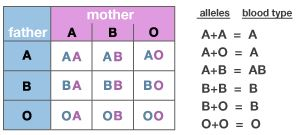
Possible combinations of blood type alleles
Blood plasma is packed with proteins called antibodies. The body produces a wide variety of antibodies that will recognize and attack foreign molecules that may enter the body from the outside world. A person's plasma does not contain any antibodies that will bind to molecules that are part of his or her own body.
When conducting a blood transfusion, it is important to carefully match the donor and recipient blood types. If the donor blood cells have surface molecules that are different from those of the recipient, antibodies in the recipient's blood recognize the donor blood as foreign. This triggers an immune response resulting in blood clotting. If the donor blood cells have surface moleculesthat are the same as those of the recipient, the recipient's body will not see them as foreign and will not mount an immune response.
There are two special blood types when it comes to blood transfusions. People with type O blood are universal donors because there are no molecules on the surface of the red blood cells that can trigger an immune response. People with type AB blood are universal recipients because they do not have any antibodies that will recognize type A or B surface molecules.
Plant and animal breeding
The process of choosing animals and plants with certain desired qualities such as increased yields, tolerance to drought, resistance to disease and faster growth is referred to as artificial selection.
Artificial breeding is done by inbreeding or crossbreeding. Inbreeding involves breeding closely-related organisms. Thus the required qualities are retained from one generation to another.
Plants with desired qualities are inbred through successive selfing. Excessive inbreeding reduces genetic diversity, health and fitness.
Crossbreeding is also called hybridization. Different varieties of the same species are interbred in order to combine the advantageous traits of one variety with those of another.
Plants are crossbred to introduce traits/genes from one variety or line into a new genetic background. For example, a mildew-resistant pea may be crossed with a high-yielding but susceptible pea, the goal of the cross being to introduce mildew resistance without losing the high-yield characteristics. Progeny from the cross would then be crossed with the high-yielding parent to ensure that the progeny were most like the high-yielding parent, (backcrossing).
Traits that breeders have tried to incorporate into crop plants include:
- Improved quality, such as increased nutrition, improved flavour, or greater beauty.
- Increased yield of the crop.
- Increased tolerance of environmental pressures (salinity, extreme temperature, and drought).
- Resistance to viruses, fungi and bacteria.
- Increased tolerance to insect pests.
- Increased tolerance of herbicides.
- Longer storage period for the harvested crop.
Artificial insemination in the livestock industry has helped to produce a wide variety of cattle breeds which produce higher yields of milk or meat or both, sheep with high quality wool and poultry which produce good meat and eggs.
Genetic counselling
Genetic counselling is giving of professional advice and information about inherited disorders and diseases so as to help people make informed decisions.
The patients or relatives at risk of an inherited disorder are advised of the consequences and nature of the disorder, the probability of developing or inheriting it, and the options open to them to avoid propagating the problem to future generations.
The advice aims at controlling or preventing inheritable diseases and disorders like sickle-cell anaemia, albinism, haemophilia, colour blindness, etc.
In general, a genetic counselling session aims at:
- increasing the family’s understanding of a genetic condition;
- discuss options regarding disease management and the risks and benefits of further testing and other options;
- helping the individual and family identify the psychosocial tools required to cope with potential outcomes; and
- reducing the family’s anxiety.
People usually seek genetic counselling at the following times:
- Before conception, when one or both parents are carriers or sufferers of a certain hereditary disorder.
- During pregnancy, if an abnormality is detected in the embryo. Genetics can help health-care professionals to identify certain conditions in babies before they are born using techniques such as prenatal testing.
- If a defect is noticed after birth.
- If a genetic condition sets in during adulthood.
Genetic counsellors advice parents on how to minimize the risk of passing on certain traits to their children. For example, marriages between close relative increases the chances of alleles being homozygous. People with genetic disorders are also taught how to control them. Genetic counselling is also used to resolve controversies over parentage.
Genetic engineering
Genetic engineering is the process of manually adding new DNA to an organism. The goal is to add one or more new traits that are not already found in that organism. Examples of genetically engineered (transgenic) organisms currently on the market include plants with resistance to some insects, plants that can tolerate herbicides, and crops with modified oil content.
Genetic engineering has been applied to produce insulin cheaply using bacteria. This is done by transferring a gene that determines insulin production in a human cell into bacteria. Since bacteria reproduce very fast, large amounts of insulin can be produced within a short time. The insulin is then extracted from the bacteria and purified in readiness for use in the treatment of diabetes mellitus in human beings.
Genetic engineering is also used in the production of interferons. Genes responsible for interferon production are inserted into the DNA of yeast. Interferon is a chemical naturally produced by cells in order to inhibit viral growth during infection. It is used in the treatment of cancer and viral diseases.
Forensics (criminal investigation)
Forensics refers to use of science and technology to investigate and establish facts in criminal or civil courts of law. The police can use DNA fingerprinting to catch criminals. This technique can identify individuals on the basis of their genetic information. In practice, the test is used to determine whether a family relationship exists between two people, to identify organisms causing a disease, and to solve crimes. Only a small sample of cells is needed for DNA fingerprinting. A drop of blood or the root of a hair contains enough DNA for testing
Criminals often leave evidence of their identity at a crime scene: for example, hair follicles, blood or skin cells. The police can use the genetic information to demonstrate whether or not an individual was present at the scene of a crime. Genetic information can prove innocence and help to identify and convict the guilty.
Also in cases such as raping, DNA test of sperm remains retrieved from the victim’s clothes or body may be used to establish evidence that could lead to conviction or release of the suspected rapist.
- READ TOPIC 3: Classification Of Living Things



No comments:
Post a Comment